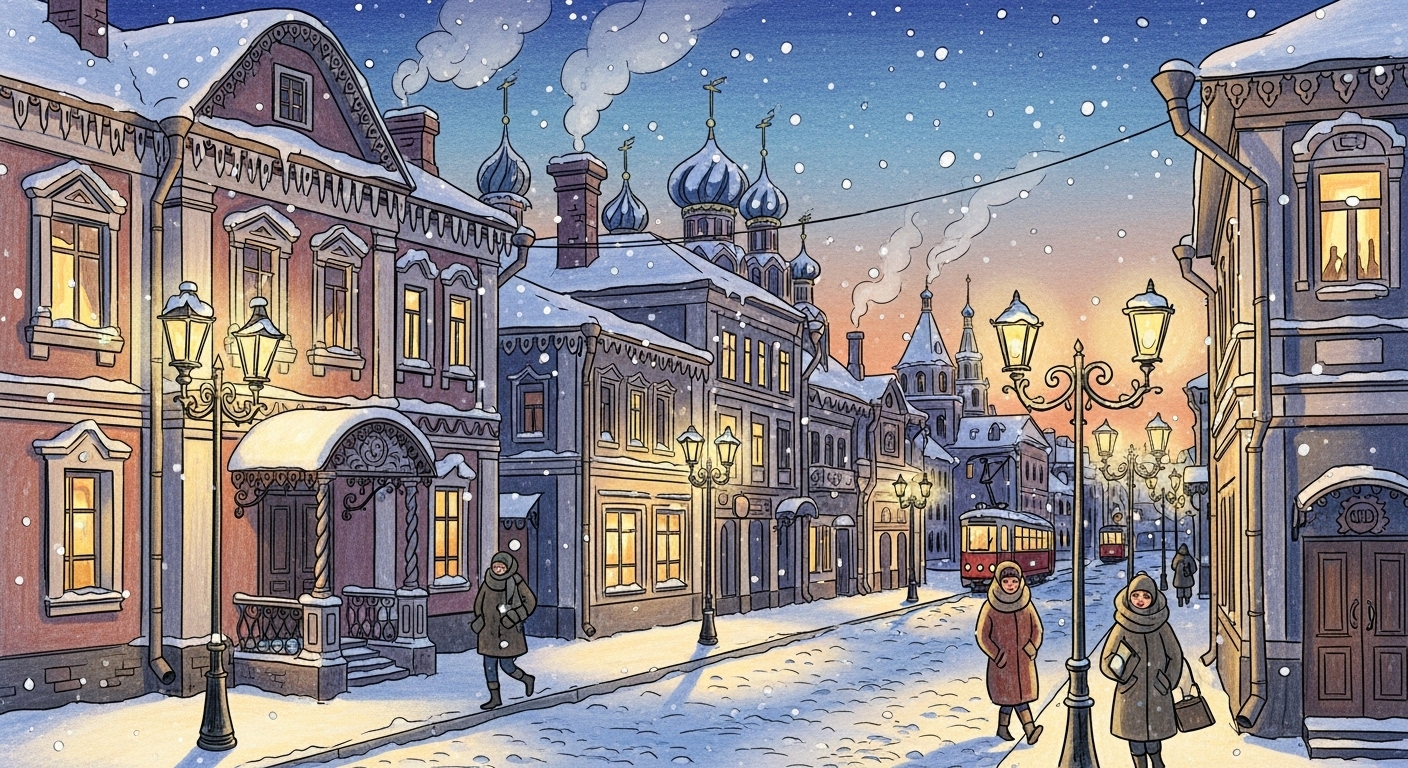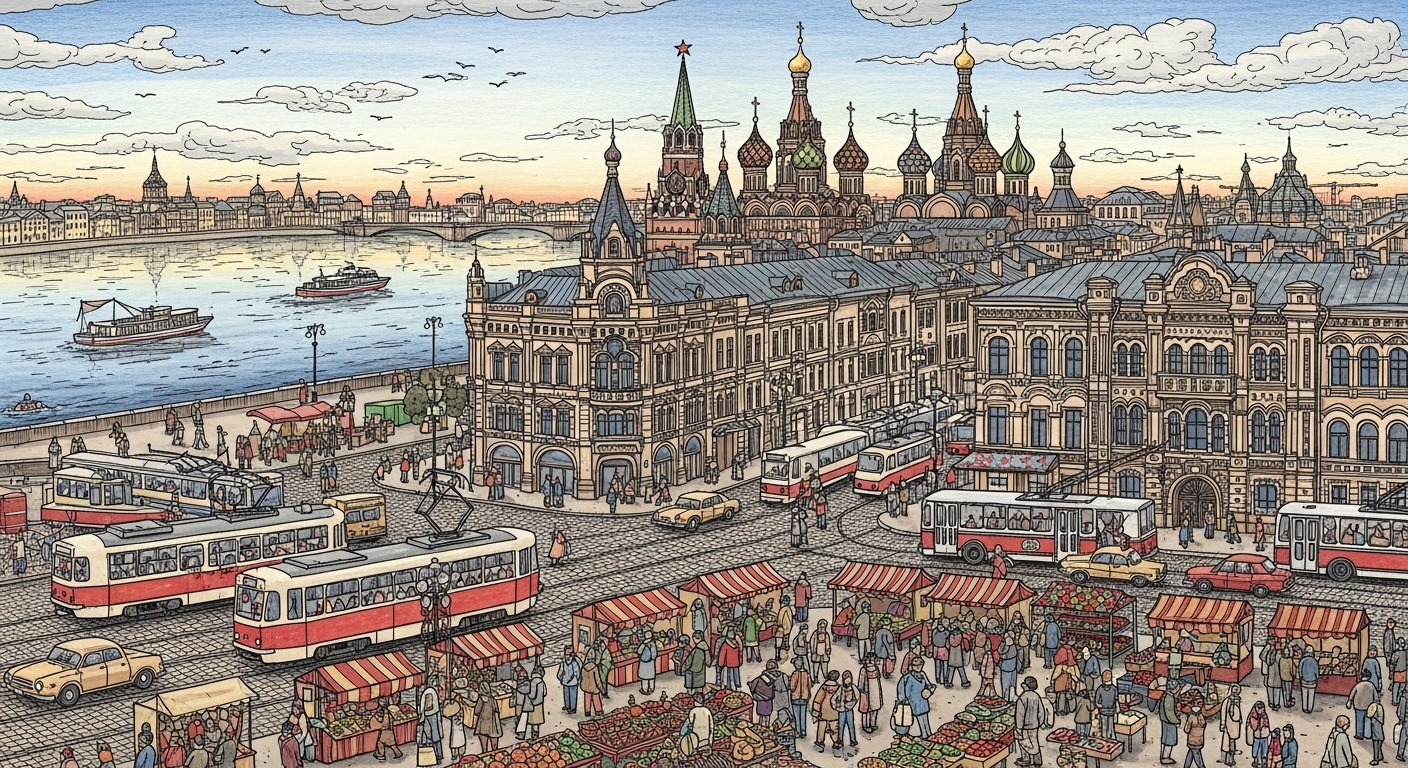Stop Saying ‘Я иду’: A Practical Guide to Russian Verbs of Motion

Your Russian is Correct, But is it… Moving? 🚶♂️
Let's be honest. You've reached a point in your Russian learning journey where you can build sentences. You can say, "Я иду в магазин" (I am going to the store), "Я иду на работу" (I am going to work), and "Я иду в парк" (I am going to the park).
Technically, you're not wrong. But does it feel a little… flat? Like you're using the same Lego brick for every single creation? If you're stuck in the world of идти, you're describing motion, but you're not telling a story. You're missing out on the beautiful, dynamic system that native speakers use to paint vivid pictures with their words.
This is a classic A2-level hurdle. You've mastered the basics, but your Russian lacks the flow and precision to sound truly natural. The secret to breaking through this barrier lies in mastering one of the most powerful (and feared) topics in Russian grammar: Verbs of Motion.
Don't run away! 🏃♀️ Forget the confusing charts and endless conjugation tables. Today, we're going to look at these verbs as what they truly are: storytelling tools. By the end of this guide, you'll have a clear framework for not only understanding them but using them to make your Russian more expressive and impressive.
The Two Speeds of Russian Motion: One-Way vs. Round-Trip
First, let's tackle the fundamental concept. In Russian, motion verbs come in pairs. One describes movement in a single, specific direction, while the other describes habitual action, round trips, or movement without a specific direction.
Think of it like this:
- Unidirectional (like a laser pointer 🔦): Happening now, one direction, one time.
идти(on foot),ехать(by transport). - Multidirectional (like a disco ball ✨): A habit, a round trip, there-and-back, ability.
ходить(on foot),ездить(by transport).
On Foot: идти (to go) vs. ходить (to go)
| Verb | Meaning | When to Use | Example |
|---|---|---|---|
| идти (idti) | to go (one way) | When you are currently on your way somewhere. | Сейчас я иду в библиотеку. (Right now, I am going to the library.) |
| ходить (khodit') | to go (habitual/round trip) | When you go somewhere regularly, or you are talking about a completed round trip. | Я хожу в библиотеку каждую неделю. (I go to the library every week.) |
Let's see it in action:
- A friend calls you. "Что ты делаешь?" (What are you doing?). You answer: "Я иду домой." (I'm on my way home). You are on a specific, one-way journey right now.
- Your friend asks about your hobbies. "Что ты делаешь по выходным?" (What do you do on weekends?). You answer: "Я хожу в кино." (I go to the movies). This is a general, repeated action.
By Transport: ехать (to go) vs. ездить (to go)
The exact same logic applies when you're in a car, bus, train, or on a bike.
| Verb | Meaning | When to Use | Example |
|---|---|---|---|
| ехать (yekhat') | to go (one way, by transport) | When you are currently on your way somewhere via transport. | Мы едем на море на машине. (We are going to the sea by car.) |
| ездить (yezdit') | to go (habitual/round trip, by transport) | When you go somewhere regularly by transport, or you are talking about a completed round trip. | Мой папа часто ездит в командировки. (My dad often goes on business trips.) |
- You're on a bus and text your friend: "Я еду к тебе." (I'm on my way to your place). Specific journey, happening now.
- You tell someone about your past job: "Раньше я ездил на работу на метро." (I used to go to work by metro). Habitual action in the past.
Mastering this core difference is the first huge step. But the real magic begins when we add prefixes.
The Storyteller's Toolkit: Adding Superpowers with Prefixes
This is where your Russian transforms from black-and-white to full color. Prefixes are small additions to the beginning of verbs that completely change their meaning. When added to verbs of motion, they give them direction, purpose, and a sense of completion.
When you add a prefix, the unidirectional/multidirectional pair changes slightly. The prefixed version of идти (like прийти) becomes the perfective aspect (a completed, one-time action), and the prefixed version of ходить (like приходить) becomes the imperfective aspect (a repeated or ongoing action). Don't worry too much about the theory; let's focus on what they do.
Here are some of the most essential prefixes that will immediately upgrade your storytelling.
1. The Prefix of Arrival: при-
This is your go-to prefix for showing someone has arrived. It answers the question, "Are they here yet?"
- прийти (priyti) - to arrive (on foot)
- приехать (priyekhat') - to arrive (by transport)
Example Story:
Анна ждала своего друга. Он позвонил и сказал: "Я уже иду". Через десять минут он пришёл. (Anna was waiting for her friend. He called and said: "I'm on my way now". Ten minutes later, he arrived.)
Мы долго ехали на поезде. Наконец, мы приехали в Санкт-Петербург ночью. (We were on the train for a long time. Finally, we arrived in Saint Petersburg at night.)
2. The Prefix of Departure: у-
This prefix signifies leaving or departing, often for good or for a significant amount of time.
- уйти (uyti) - to leave, to go away (on foot)
- уехать (uyekhat') - to leave, to go away (by transport)
Example Story:
Вечеринка была скучная. Мы не хотели оставаться, поэтому мы ушли. (The party was boring. We didn't want to stay, so we left.)
Моя сестра уехала учиться в другой город. Я скучаю по ней. (My sister left to study in another city. I miss her.)
3. The Prefix of Entering: в- / во-
Use this to describe someone entering a closed space, like a room, building, or car.
- войти (voyti) - to enter, to come in (on foot)
- въехать (v'yekhat') - to enter, to drive in (by transport)
Example Story:
Было холодно. Я открыл дверь и вошёл в дом. Внутри было тепло. (It was cold. I opened the door and entered the house. It was warm inside.)
Он завёл машину и медленно въехал в гараж. (He started the car and slowly drove into the garage.)
4. The Prefix of Exiting: вы-
This is the opposite of в-. It means to exit or go out of a closed space.
- выйти (vyyti) - to exit, to go out (on foot)
- выехать (vyyekhat') - to exit, to drive out (by transport)
Example Story:
Он услышал странный звук и вышел на улицу посмотреть, что случилось. (He heard a strange sound and went out into the street to see what happened.)
Каждое утро я выезжаю из гаража в 8 часов. (Every morning I drive out of the garage at 8 o'clock.)
5. The Prefix of Beginning: по-
This simple prefix is incredibly useful. It signifies the start of a motion. It's the perfect way to say someone "set off" or "started going".
- пойти (poyti) - to set off, to start going (on foot)
- поехать (poyekhat') - to set off, to start going (by transport)
Example Story:
Мы поужинали, а потом пошли гулять в парк. (We had dinner, and then we went for a walk in the park.)
"Уже поздно, нам пора домой", - сказала мама, и мы поехали. ("It's late, it's time for us to go home," said mom, and we set off.)
By learning just these five prefixes, you can now tell a simple story: Утром мы **поехали** за город. Мы **приехали** в деревню в полдень. Мы **вошли** в старый дом. Вечером мы **уехали** обратно в город. (In the morning we set off for the countryside. We arrived in the village at noon. We entered the old house. In the evening we left to go back to the city.)
See how much more alive that feels than just saying ехать over and over?
The Practice Paradox: Why Knowing the Rules Isn't Enough
So now you understand the logic. при- means arrival, у- means departure. Simple, right?
But then you try to write a short paragraph about your day, and the questions start flooding in:
- "I left the house." Is that
ушёл из домаorвышел из дома? (Hint:вышелis usually better for simply stepping out). - Where can I find stories that use these verbs naturally so I can see how they work?
- How do I know if I'm using them correctly? Who is going to check my writing and tell me why my choice of
пойтиwas wrong in a specific context?
This is the gap between passive knowledge and active skill. Reading a blog post is a great start, but to truly master these verbs, you need to engage in a cycle of learning, practicing, and getting feedback. This is often the hardest part to do on your own.
The Practice Accelerator: How to Master Motion Verbs Faster
What if you could create the perfect environment to practice exactly this skill? An environment that provides endless, level-appropriate content and gives you instant, intelligent feedback on your attempts to use these new storytelling verbs.
This is precisely why we built Toritark. It’s designed to bridge the gap between knowing the grammar and using it fluently.
Here’s how you can use the Toritark cycle to master verbs of motion:
1. Get Your Perfect Story 📖 Instead of searching for texts, you generate them. In the Toritark app, you can choose a topic like "A trip to a friend's dacha" or "My morning routine." The AI will instantly write a unique, short story for you at your A2 level. These stories are full of natural language, including the very verbs of motion we've just discussed.
2. Read and Absorb in Context 🧠
As you read the story on Toritark, you'll see these verbs in their natural habitat. If you encounter a sentence like, Он подошёл к окну (He walked up to the window) and you're not sure about the prefix подо-, you can long-press the sentence for an instant translation. See a verb you want to master, like переехать (to move house)? Long-press the word to save it directly to your personal vocabulary list.
3. The Magic Step: Retell the Story and Get Feedback ✍️✅
This is where your learning goes into overdrive. After reading, Toritark prompts you: "Retell this story in your own words." This is your chance to actively use приехать, выйти, and пойти. You try your best to reconstruct the narrative.
Then, the magic happens. You submit your text, and our AI gives you an incredible, multi-layered analysis. It doesn't just give you a score. It shows your text side-by-side with a corrected version and explains the errors:
- Your Text:
Я ушёл из дома и пошёл в магазин. - AI Feedback: "Grammar Correction: The verb
ушёлimplies leaving for a long time. Since you are describing a simple trip to the store,вышел(exited) is more natural here.Я вышел из дома и пошёл в магазин.This correction improves the idiomatic flow of your sentence."
This kind of instant, precise feedback on your active writing is the fastest way to build an intuitive feel for which verb to use.
4. Master the Verbs in Context 🎯
Finally, all those verbs like войти and уехать that you saved go into a special training mode. Toritark creates fill-in-the-blank exercises using the exact sentences from the stories you read. You'll see Анна ______ в комнату and have to choose the correct verb, reinforcing the word in its original context.
Start Your Journey Today
Russian verbs of motion aren't just a grammar rule to be memorized. They are the engine of Russian storytelling. They add depth, direction, and life to your sentences.
Start by mastering the basic pairs: идти/ходить and ехать/ездить. Then, begin to sprinkle in prefixes like при-, у-, в-, вы-, and по-. Write short stories about your day, a trip you took, or a movie you watched, focusing on describing the movement.
And if you want to supercharge that process with endless content and instant, tutor-like feedback, give Toritark a try. It’s built to turn this exact kind of frustrating grammar point into a skill you can use with confidence.
Stop just stating facts. Start telling stories. Поехали!
Finally, Speak with Confidence
📖 Read short stories adapted to your level.
✍️ Retell them & get instant AI corrections on your writing.
🧠 Master new words in their real context.
Similar posts

From 'Привет' to Paragraphs: A Beginner's Guide to Writing Your First Russian Stories
Struggling to move beyond single Russian words? Learn a simple method to start writing your first stories today, even with a small vocabulary. It's time to build, not just collect.

The Russian Learner's 'Reading Trap': Why You Understand Words But Can't Write Sentences
Feel stuck in a cycle of reading Russian but being unable to write? Discover the 'Reading Trap' and learn a 3-step method to activate your vocabulary and start writing your first stories today.

Your Russian Writing Is a List of Facts. Here’s How to Weave a Narrative.
Stuck writing choppy, disconnected Russian sentences? Learn how to use connectors, clauses, and narrative flow to transform your writing from a list of facts into a compelling story.

Every Russian Noun Has a Secret GPS. Here's How to Read It.
Stop getting lost in Russian grammar. Discover the simple mental model that turns confusing noun endings into a GPS, guiding you to build your first correct sentences.

Your Russian Sentences Are Islands. Here's How to Build the Bridges.
Tired of writing short, robotic Russian sentences? Learn the simple 'bridge-building' techniques using conjunctions and connectors to write with natural flow.